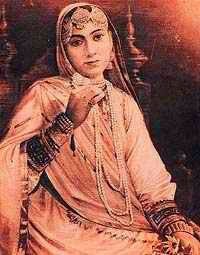Jindan Kaur
Maharani Jind Kaur, (1817 in Chachar, Gujranwala, Sikh Empire – 1 August 1863 in London, United Kingdom) also popularly known as Rani Jindan. She was the youngest wife of Maharajah Ranjit Singh and the mother of the last Sikh Emperor, Maharajah Duleep Singh. In 1845 she became Regent of Punjab for Duleep Singh. The Queen Mother (or Mai) of the last Sikh sovereign of the Punjab. She was renowned for her great beauty and personal charm along with her 'characteristic strength of a man' qualities which the British came to dislike.
Rani Jindan was the daughter of Sardar Manna Singh, a Sikh Khalsa of small village of Chachar, in the district of Gujranwala, now in Pakistan. It was reported that Maharaja Ranjit Singh was not interested in marrying a young bride, reportedly she would be his 17th wife. The tender years of Duleep Singh, is the reason why the Maharani did not become 'sati' on the funeral pyre of her husband along with some of the other wives (Which is Against Sikh Teachings). In order to get rid of Manna Singh's constant requests, the Maharaja sent 'his arrow and sword' to her village to which Jind Kaur was symbolically married in 1835 AD. Ranjit Singh had married nine of his wives with the usual rites and ceremonies of the institution of Anand Karaj (Sikh religious marriage ceremony) and the other seven with the less orthodox customs of 'Chaddar-Pauna', 'Karewa' or ' Tir-patka' , a prevalent custom among the Jats of the Punjab. This custom was born from the Sikh religion's rejection of the ancient ritual of 'Sati' or self-immolation of the widow on her husband's funeral pyre, a custom which was still prevalent within most of the families of the nobility and royalty of the Sikh Kingdoms. The Sikh custom allowed the eldest (or younger brother) of the deceased to symbolically marry the widow by placing a 'nath' or nose-ring in the nose of the widow whilst both seated under a white sheet held aloft by members of the family.

Shortly after the First Anglo-Sikh War saw the British gain hold of Punjab, and in 1846 she was deposed as Regent, forcibly separated from her only son and banished to Sheikhupura near Lahore.
After moving around several gaols, Rani Jindan eventually escaped from Chunar fort, Uttar Pradesh on 19 April 1849 and left a note for the British "You put me in the cage and locked me up. For all your locks and your sentries, I got out by my magic ... I had told you plainly not to push me too hard – but don’t think I ran away, understand well, that I escape by myself unaided ... When I quit the Fort of Chunar I threw down two papers on my gaddi and one I threw on the European charpoy, now don’t imagine, I got out like a thief". The British confiscated her jewelry and rescinded her pension. Rani Jindan arrived in Kathmandu, Nepal on 29 April 1849 and was given political asylum by Prime Minister Jung Bahadur. She was assigned a residence at Thapathall and given an allowance by the Nepalese government.
In 1860 she was eventually permitted to see her son, Maharaja Duleep Singh in Calcutta, who brought her to the shores of England.
